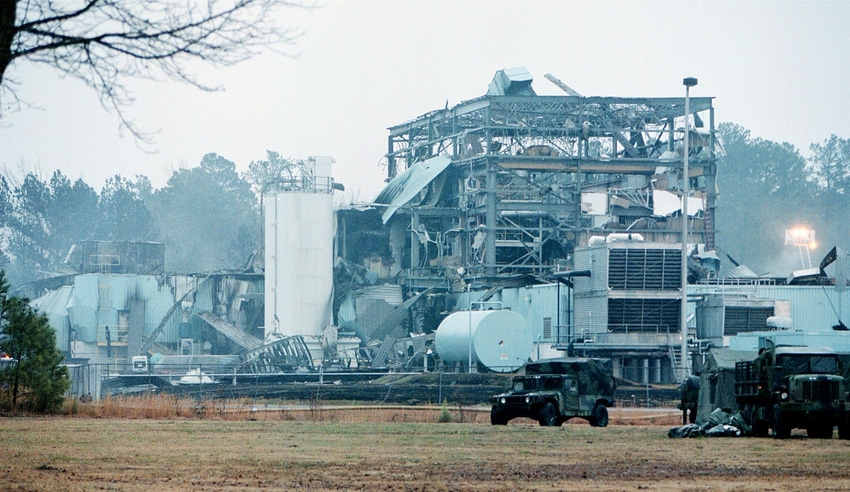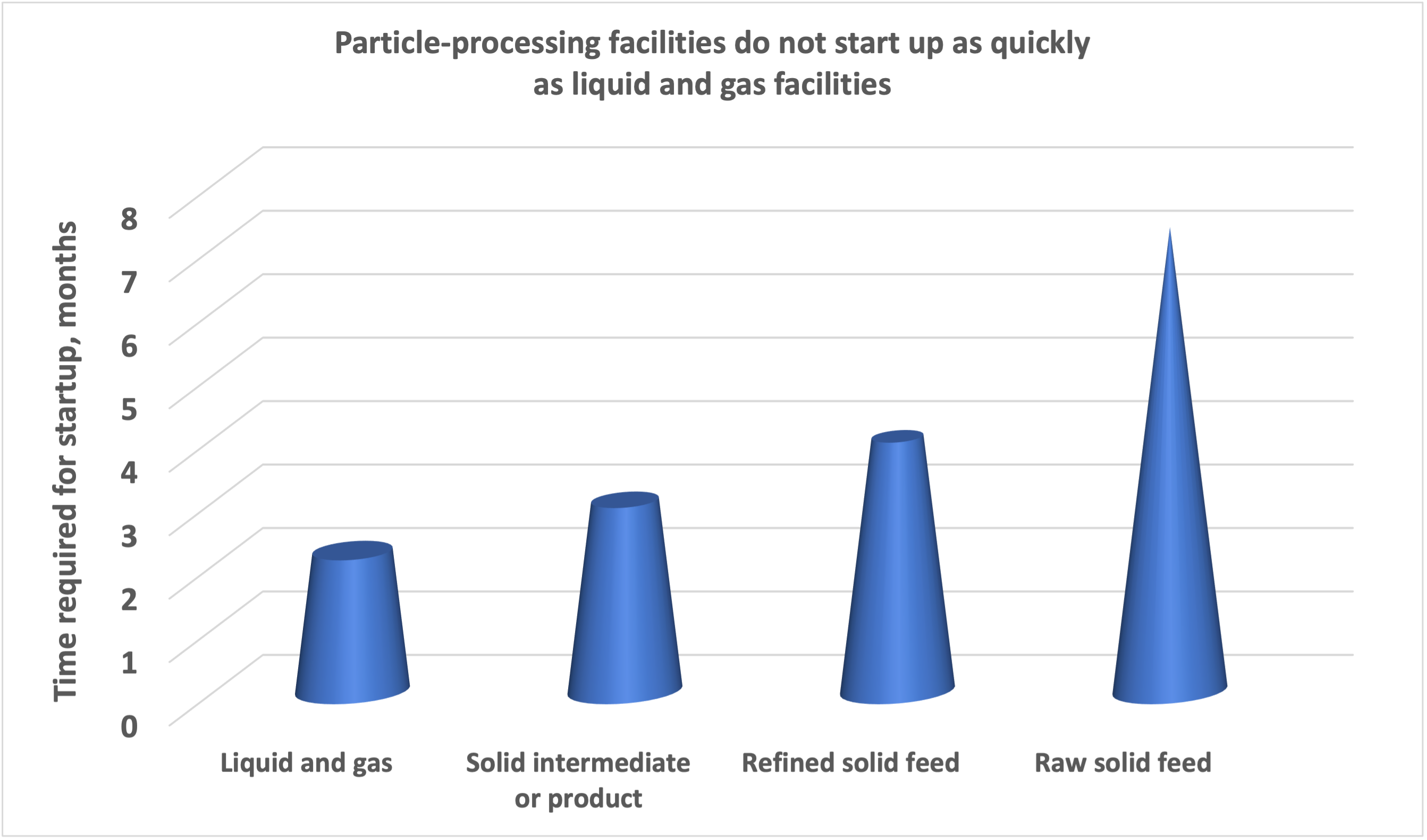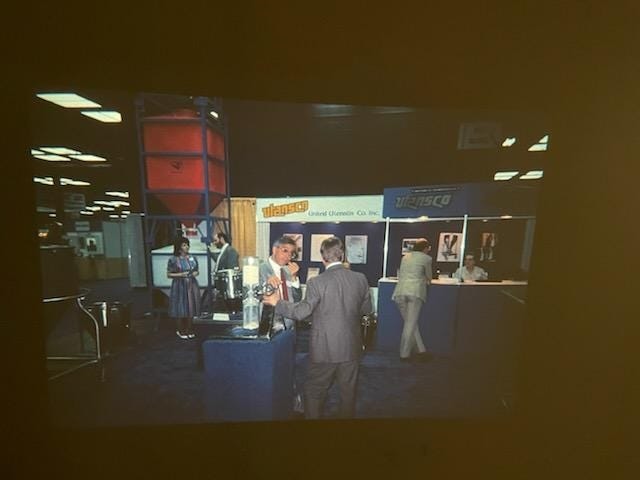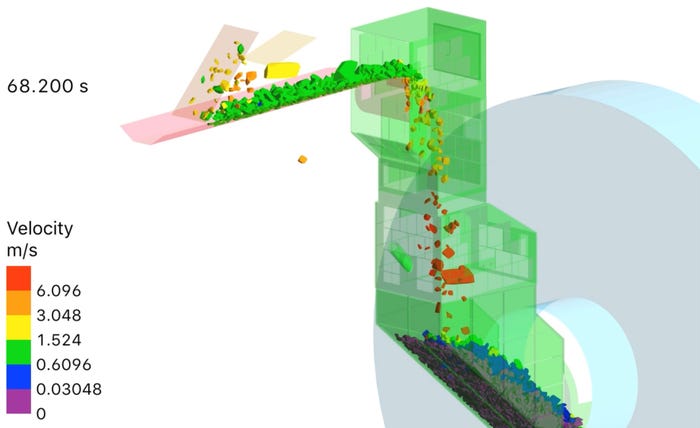40 Years of Dry Processing and Bulk Solids Handling: Challenges, Changes, and Successes
Bulk solids science has advanced significantly over the past half a century, yet there is much more to explore and develop.

For some historical context, when Powder & Bulk Solids published its first issue in 1983, Ronald Reagan was completing his first term as US president, and the global economy was starting to emerge from the stagflation of the 1970s. The global population was approximately 4.7 billion1 (half of what it is today), and Space Shuttle missions were starting to take astronauts to orbit regularly. The US military’s ARPANET was officially switching to use the Internet Protocol, marking the birth of the Internet.
While the first issue of Powder & Bulk Solids in 1983 may not have made the national headlines, it was the start of an important role the publication plays in a field that touches so many parts of our daily lives. Bulk solids science has advanced significantly over the past half a century, and yet there is much more to explore and develop, as we discuss below.
Industry Challenges Through Four Decades
Pre-1980s Challenges
Though bulk solids handling science had been in development since Andrew Jenike’s work in the 1950s, it was at its infancy, and old design habits persisted. Engineers designing bulk solids handling equipment using T-squares and triangles found 60° to be a convenient hopper angle for bins and silos. Furthermore, pyramidal-shaped hoppers--with four flat walls welded together--provided a low-cost, easy-to-fabricate solution, which unfortunately yielded the least reliable flow behavior. A lack of Computer Aided Design (CAD) and three-dimensional modeling contributed to design errors with storage and conveying systems, causing major process inefficiencies, safety concerns, and product quality issues.

Andrew Jenike (image courtesy of Jenike & Johanson)
Engineers throughout the world are trained on the behaviors of solids, liquids, and gases. However, education on bulk solids handling during this period was nearly nonexistent. Only a handful of universities had any faculty with expertise or industrial experience with bulk solids. Even major engineering societies such as AIChE or ASME had educational blind spots in this important technology area.
Though Andrew Jenike’s foundational first-principles theory of the flow of bulk solids was published in the 1960s, its effective adoption in industries such as foods, plastics, metals, and pharmaceuticals was slow. Additionally, distribution of educational content on bulk solids handling was limited to only a handful of industry publications and conferences with minimal world-wide participation.
80s and 90s Challenges
These decades are considered major inflection points in the information age. Though 75% of the 80s and 90s did not have email or internet, major advances occurred with computers, electronics, instrumentation, and controls. Facilities handling bulk solids such as grains, ores, fossil fuels, and plastics were expected to manufacture products faster and safer. Often in-company subject matter experts were available to guide others, including engineers, avoiding costly mistakes learned during their decades of experience. Workers commonly stayed employed at companies for many years as loyalty prevailed and opportunities for growth existed accompanied by valuable experience.
As the global economies expanded in these decades, the need for increased factory throughput drove automation and increased process scaling. Automating and scaling-up handling systems require bulk solids handling expertise. While many engineers study liquids and gases in their formal education, they lack understanding of bulk solids. Utilizing liquid and gas scale-up methods for solids proved to be detrimental. For instance, as coal production increased to meet electricity needs, larger coal storage bunkers and stockpiles were needed at power plants. Though storage capacities increased, so did bunker and pile fires caused by spontaneous combustion of stagnant coal. Flow reliability decreased due to increased bridging and ratholing in bunkers and stockpiles.
Production quality improvements driven by Statistical Process Control (SPC) and Six Sigma initiatives were pervasive in these decades. In situations involving bulk solids handling, poor and/or erratic flow negatively affected the overall results of SPC, given out-of-control processes are difficult to fine tune. Even increased automation of processes struggled where solids were subject to caking, segregation, or flow rate limitations, all of which are common material handling challenges in food, chemical, and pharmaceutical industries.

Fig 2: Processing with powders and solids can take significantly longer to start up compared to liquids and gases. (image courtesy of Jenike & Johanson; recreated from Rand Study)
In the early 1980s, the US Department of Energy commissioned the RAND Corp. to investigate the performance of 37 US- and Canada-based processing plants. The study reviewed how solids, liquids, and gases were processed during feed, intermediate, and final product conditions.
Key findings from the Rand study2 follow:
Facilities handling bulk solids performed worse than those handling liquids or gases only.
Two-thirds of the plants handling bulk solids operated at less than 80% of their nameplate capacity at the end of their first year, with a quarter failing to reach even 40%. The average for this group was 64% of nameplate compared to more than 90% for liquidgas operations.
“By far the most common problems resulted from the tendency of solids to plug, stick, flow unevenly, and go where they should not (often, in the form of dust).”3
The major root causes of these failures were lack of knowledge around heat and material balances, particularly with the flow of bulk solids.
Only 6% of the 37 plants studied had no major performance issues, and most problems involved were related to bulk solids behavior and not chemistry.
When compared to facilities built in the 1960s (20 years prior) there was no difference (i.e., signs of improvement). The improvement effort during that period was found to be focused on process chemistry as opposed to mechanical processes (understanding flow and doing the bulk solids science homework).
00s to Present Challenges
The world survived “Y2K” at the turn of the century, and the advent of the information age made possible centrally controlled and monitored processes that allowed massive production growth in all types of industries through the housing boom up to the Global Financial Crisis of 2008. As the economy expanded over a decade from the “dotcom” period in the late 1990s to the GFC, demand for foods, metals, fossil fuels, consumer goods, plastics, cement/concrete, and building materials rose rapidly.
Consumer goods diversity emerged with wide product offerings to meet the insatiable global appetite. This required manufacturing facilities to retool their factories toward customization and agile production methods to meet the fickle demands of their previously loyal customer base.
For instance, in the 1970s, there were only a handful of dry beverage juice drinks, such as those with flavors of cherry, grape, and lemonade. A factory back then could easily blend the main ingredients of sugar, pectin, citric acid, and simple flavors to mass produce a product that consumers loyally purchased. Fast-forward to current times, whereby dry beverage manufacturers have to produce hundreds of Stock Keeping Units (SKUs) that have varying flavors, sweetness, natural or artificial sweeteners, with or without additives providing minerals, or even nutraceuticals. Instead of having silos with sugar and citric acid with minor flavor bins, the modern factory must handle dozens of large ingredients in banks of silos, along with portable bin containers or bulk bags for intermediate additives, with paper sacks or bottles for minors. The range of flow characteristics encountered at these facilities is mind-boggling, and designing storage, discharge, and feeding equipment to reliably handle all of these materials without flow obstructions, caking, attrition, or segregation requires the use of solids handling technology.
In addition to the handling challenges, the increased number of ingredients also resulted in not only more frequent dust explosions but also continued loss of life. Many of the bulk solids handled in agriculture, plastics, metals, foods, pharmaceuticals, and wood/biomass industries are susceptible to deflagrations (i.e., fire, flash fire, or dust explosion) when the right combination of ingredients for a combustible dust event are present. In an unfortunate catastrophic explosion in 2008, 14 workers were killed4. The explosion, which was caused by ignition of a sugar dust cloud in a covered belt conveyor, resulted in $60M in damages. In another example, a massive plant explosion at Didion Milling in 20175 killed five workers and injured 11 due to a dry corn product deflagration in a fluid bed dryer. Recall two decades ago with West Pharmaceuticals6 and its massive dust explosion event, whereby six were killed and dozens injured from fine plastic powder dust deflagration.
Worldwide factories continue to employ a range of dust collectors, bucket elevators, ovens/dryers, mills/grinders, mixers/blenders, pneumatic conveying systems, and silos/bins/hoppers to store, process, and transport all types of powders and bulk solids, many of which can be subject to combustible dust hazards. Increased attention has been given to combustible dust hazards, and what measures could be taken to eliminate or reduce the likelihood of hazards. In fact, the National Fire Protection Association (NFPA) is currently developing Standard 660, which will be a promulgation of several of the individual combustible dust standards whether for fundamentals (NFPA 652), design (NFPA 654 and 91), or commodity specific for wood, sulfur, metals, and food/agriculture (NFPA 664, 655, 484, and 61). This will have a positive effect on education and practical use by a myriad of industries handling combustible dusts as the new standard will provide simplification on fundamentals common to each standard, as well as unique hazard recognition and mitigations for commodity specific situations.
The turn of the century also witnessed increased recycling in a variety of industries like glass, plastics, and metals. Though glass and metals readily incorporated post-consumer recycle scrap, plastics recycling remains difficult due to several types of plastics that often cannot be mixed into a single stream. Separation of polyethylene from polypropylene can be difficult, and as a result, the captured mixed recycle stream is commonly landfilled wasting (literally) the recycling efforts.
Another important bulk solids handling challenge over the past two decades has been the incorporation of biomass or alternative fuels with fossil fuels. An example of this is the co-firing of wood chips with bituminous coal. Though the heating value of the wood and coal is often similar, the low density of the wood chips requires nearly two or three times the volume of material to be mixed in with coal for stochiometric combustion as a pulverized mixture. This creates handling problems with the coal/chips blend, often resulting in flow obstructions and segregation issues. Furthermore, using coal pulverizing equipment, such as ball or rod mills, does not typically work well with wood chips, which require hammermills for size reduction. This mismatch of equipment requires process modifications incurring additional costs and project time.
Fossil fuel combustion plants also implemented costly back-end-technologies for air pollution control to abate harmful emissions leading to acid rain and mercury release. This environmental and public health necessity came at the cost of handling difficult reagents like hydrated lime, prilled urea, and activated carbon, as well as byproducts such as synthetic gypsum and coal ash.
Another challenge facing manufacturing over the past few decades is that of technical staff turnover and retention. Though many engineers enjoyed longevity at manufacturing facilities before the turn of the century, staff attrition has negatively affected knowledge transfer to replacement staff (assuming there is replacement). Some companies have eliminated their engineering staff through outsourcing to engineering/procurement/construction (EPC) firms. In some cases, this has worked acceptably; in other cases, the lack of internal engineering staff with prior project experience and specialized knowledge has resulted in process inefficiencies, costly design mistakes, and poor sustainability. In earlier decades, engineers would often develop a process with equipment components that they sized, specified, procured, and installed. In the past two decades, many companies have turned to equipment vendors that could provide comprehensive turnkey packages with sole source responsibilities for process specification, design, fabrication, installation, and commissioning. Though this has worked in many industries for a myriad of applications, it has at times suffered from a lack of comprehensive engineering process and left a knowledge gap at factories given the bulk solids handling insights have remained with the vendors.
Industry Changes Through Four Decades
While there have been significant challenges in solids handling over the past four decades, there have also been notable advances.
80s and 90s Advances
Educational opportunities for powder and bulk solids handling science and technology grew significantly in the 80s and 90s. Powder & Bulk Solids magazine certainly had a role to play with its focus on technology, equipment, and vendors servicing the myriad of industries handling bulk materials (each month’s issue was dutifully added to our library shelves and often referenced by our engineers). The International Powder & Bulk Solids Conference and Exhibition held annually outside Chicago, IL and similar conferences held in Europe and even Australia offered great opportunities for learning and information exchange. Given bulk solids and powder technology were generally not taught in US universities, many engineers would learn about important flow phenomena at specialized courses taught at these conferences, or through periodicals or books that began emerging during these decades. Furthermore, AIChE began offering an intensive two-day course on bulk solids flow fundamentals, taught by experienced Jenike & Johanson engineers. This course, along with a fundamentals course on pneumatic transport, remains in the top three most popular courses offered by AIChE.

Insert Fig 4: Powder & Bulk Solids Conference & Exhibition circa 1980s (image courtesy of Jenike & Johanson)
Another advancement in these decades was with flow aids, such as air cannons and vibrators. There can often be a sharp difference of opinion regarding their effectiveness in initiating or enhancing flow. In some cases, they can be quite effective; in others, they can cause more problems than intended to solve. Air cannons evolved to not only help overcome bridging problems with materials that remained at rest, but also for use with buildup and unclogging of stubborn transfer chutes. Though air cannon application is generally science based with air shock and pressure wave theory, application of vibration is usually via trial-and-error as first-principles theory has not effectively been developed.
Off-shoring of manufacturing in the US in the 80s and 90s--whether it be computer chips, electronics, appliances, shoes and garments, or furniture--had a big impact on the powder and solids handling industry. First, in some cases, there was a loss of material handling knowledge as manufacturing moved to low-cost countries that preferred brute-force, labor intensive methods over efficiency. Second, quality often suffered due to the use of inferior feedstocks or lack of quality checks and assurances. Third, impacts occurred with returning products to the US, especially if in powder or solid form (e.g., specialty chemicals, pharmaceutical active ingredients, and excipients). Materials returned to the US could be caked or damaged in some other means due to transoceanic shipment.
These decades also saw emersion of new instrumentation and controls, with distributed integrated networks linking to control rooms for remote monitoring and operations. In fact, a 2,000 ton per day cement plant in the 1970s may have needed a work force of 350 to operate, while with the advent of control systems and remote operations, cement plants by the end of the 1990s needed half that staff.
Another sea-change was with material characterization and pilot-scale modeling of powder and solids processes. Due to the success of conferences, periodicals, courses, and books on material flow fundamentals, many companies handling bulk solids became aware of the negative impacts of poor solids flow. Some large companies, such as Dow, DuPont, and Procter & Gamble, invested in a dedicated solids handling technology group as business units specialized in producing solids whether they were resins, seeds, specialty pigments, or consumer goods like soap or chips.
Process hazard analyses7 (PHAs) became more prevalent in these decades, as they were vital to assessing hazards and risks with highly hazardous chemicals. Though risks with gases and liquids are often reviewed, there remained major knowledge and experience gaps with hazards from combustible dusts.
00s to Present Advances
The turn of the millennium saw a significant increase in information exchange with bulk solids handling due to the rapid growth of the internet. As dial-up faded out and fiber optic and digital networks blossomed, exchange of information via email and PDF files quickly replaced clipped articles.
Another important change to the industry was the emersion of ASTM standards for characterizing powders and bulk solids. ASTM standards D6128/D6773 provided methodology and precision for measuring cohesive strength and wall friction angles, while D6940/D6941 provided test methods for segregation behaviors by sifting and fluidization mechanisms. A standard method for measuring the bulk density and compressibility of a powder or bulk solid was released in D6683.
Automation and distributed control systems with wireless technology and remote operation became routine for major manufacturing facilities whereby plant managers could monitor and control (if needed) the plant. Reliance on localized personnel operations reduced, while an increase on SPC and labor cost reductions occurred. Automation allowed some mines to implement autonomous vehicles that were monitored from locations hundreds of miles away. This also created a newer threat with remote control operations where cybersecurity risks loomed large. There have been several recent major news events illustrating where plant operations were hijacked (2021 Colonial Pipeline8) by the weak link of a single password failure.
As manufacturing facilities domestically began to lose engineering staff either through attrition, retirements, or consolidation, engineering and equipment firms stepped up with offerings of complete or turnkey bulk solids handling systems. Facilities were pleased in many cases with this approach as a sole-source responsibility for project management, design, build, install, and start-up/commission was provided. This helped to reduce hand-off misses or gaps in equipment trains, but also created stretch design situations where some vendors incorporated ancillary technologies they were not fully familiar with.
The plastics industry expanded rapidly in the past few decades through processing vessels increasing from 3 to 8 m diameter and yielding up to 1 billion tons per year capacity for polypropylene and polyethylene. Plastics have been in the forefront of continuous manufacturing with minimal change-over times during grade adjustments, especially effective when employing mass flow technology.
The US has been the top CO2 emitter9 and is now pivoting towards aggressive CO2 reduction goals. Specialized carbon capture technologies are being developed where bulk solids handling science plays an important role. Whether absorbing gases on granular solids or on thin layers of receptive powders, reliable, consistent, and accurate material handling is key to the success of these emerging technologies. Solar and battery storage technologies are accelerating rapidly. However, there are substantial environmental impacts with aggressive mining and wet process chemical refinement of silicon and spodumene ore (lithium aluminum inosilicate).
Additive Manufacturing (AM or “3D printing”) technology is growing rapidly. AM is a process of making parts in layers in a semi-compact sized machine directly from CAD software output, without the need for complex and costly tools and with minimal waste material (near net shape). Some have described a shoe factory filled with a thousand AM machines producing custom shoes; clearly economies of scale apply and may preclude this approach.
AM still must deal with powder segregation, particle density variability, and particle weight issues that have been plaguing it for decades. Additionally, dust hazards analysis (DHA) of processes with combustible particulate solids or dusts will be important with reducing or eliminating risks of fires, flash fires, or dust explosions with not only metals, but also plastics, wood, foods, pharmaceuticals, and many specialty chemicals.

Insert Fig 5: Discrete element method (DEM) simulation of abrasive ore feed to SAG mill. (image courtesy of Jenike & Johanson)
Bulk solids handling issues like chute plugging, limited-live stockpile capacity, and abrasive wear of equipment are continually experienced in the mining industry. As Discrete Element Method (DEM)10 technology and education improve, focus will pivot towards prevention rather than costly retrofits. In fact, process simulations via multi-physics where fluids and gases are modeled alongside particles will be commonplace. Digital twins, where there is a digital representation of a physical object or process contextualized in a digital version of its environment, will help companies to assess process variability and to cost-effectively tune operations with minimal risks.
The Future of Dry Processing and Bulk Solids Handling
As one can imagine, there are a myriad of future challenges with respect to powders and bulk solids. There are new bulk solids yet to be discovered with unique properties. For instance, consider nano-powders where the average particle size ranges from 1 to 100 nanometers (copy paper thickness is about 100,000 nanometers). These tiny particles are composed of hundreds of atoms and have a massive surface area-to-volume ratio making them attractive as catalysts, for optics, and even having quantum effects abilities. However, there are important considerations for dust explosion hazards, especially with nano-metals, and toxicity concerns as nanoparticles can readily cross into the blood barrier through lung tissue exposure.
Bulk solids handling also has an impact on our environment in dozens of ways. Mines for minerals are rapidly searching for new technologies that reduce energy use and minimize water use for washing, leaching, purifying, and dedusting. If mines increase their solids throughput yields, yet ignore basic material handling principles, greater dusting problems could easily occur. Subsea mining is at its infancy with massive potential for metals, particularly nickel, manganese, cobalt, and lithium. The challenge will be transporting these bulk solids several miles in piping under extreme pressures and separating the minerals from the sea water without causing major disruption to the seabed or ocean.
Green energy initiatives, such as green ammonia to make fertilizer, or the cracking of methane gas to yield “green hydrogen” are attractive given they do not derive from oil. However, they do yield a carbon bulk solids by-product that is transformed into “carbon black.” For those familiar with carbon black and its typical horrendous handling properties, watch out for scale-up with those processes!
Automation will continue its massive penetration into manufacturing, as we have witnessed for the past four decades. Reliable material handling plays an even greater role with automation as control logic will not be able to easily compensate for flow interruptions caused by bridging or ratholing, which can completely stop a process. Engineers and process designers should recognize that proper bulk solids equipment design must come before adding layers of automation and control. This can be a hard lesson to learn for the uninitiated. Again, this requires increased automation for all types of bulk material handling operations such as feedstock loading, storing, blending, sizing, processing of all types, packaging, and shipping. Though artificial intelligence (AI) has a role here, if automation does not have reliable handling based on first principles, then no amount of electronics and controls can meet the facility demands. Continued education of engineers in bulk solids is critical.

Insert Fig 6 - Mars Rover (courtesy of NASA via Getty Images)
One of the last challenges to be mentioned is that beyond our planet. NASA has been studying reclaim and processing of lunar regolith, as well as simulants for Martian soil. As some may have observed, one of the Mars rovers experienced difficulties drilling into the soil11, whereby the resistance on the drill caused the rover to rotate (Newton’s 3rd Law in action). Think also about handling lunar soil in 1/6th the gravity of Earth. Trust us when we say that flow obstructions do not decrease when gravity reduces. In fact, it is the complete opposite as Andrew Jenike demonstrated!
Pandemic? ‘Nuff said.
Summary
Bulk solids handling systems have come a long way from needing a sledgehammer next to each bin and silo. Many operations have embraced bulk solids handling technology as a reliable means to avoid and solve problems associated with bulk solids. There is no reason this technology shouldn’t be employed in every instance bulk solids are handled, so that a future Rand study can conclude there is little difference between solids handling plants and those handling gases and fluids. This would result in tremendous benefit to the world with operations that keep operators safe and produce high-quality products at desired rates with minimal energy and water use.
Herman Purutyan is CEO, and Eric Maynard is vice president, Jenike & Johanson Inc. (Tyngsboro, MA). For more information, call 978-649-3300 or visit jenike.com.
References
1 https://www.worldbank.org/en/home
2 Merrow, E., Myers, C., Phillips, K., “Understanding cost growth and performance shortfalls in pioneer chemical process plants,” RAND Corp., Santa Monica, CA, 1981.
3 Merrow, E. W, “Estimating Startup Times for Solids-Processing Plants”, Chemical Engineering, October 1988
4 http://www.csb.gov/imperial-sugar-company-dust-explosion-and-fire ; report no. 2008-05-I-GA September 2009
6 https://www.csb.gov/west-pharmaceutical-services-dust-explosion-and-fire
7 https://en.wikipedia.org/wiki/Process_hazard_analysis
9 https://www.ucsusa.org/resources/each-countrys-share-co2-emissions
10 https://jenike.com/our-services/discrete-element-modeling
11 https://www.space.com/37486-mars-rover-curiosity-drill-issues-continue.html
About the Author(s)
You May Also Like
.jpg?width=100&auto=webp&quality=80&disable=upscale)
.jpg?width=400&auto=webp&quality=80&disable=upscale)


